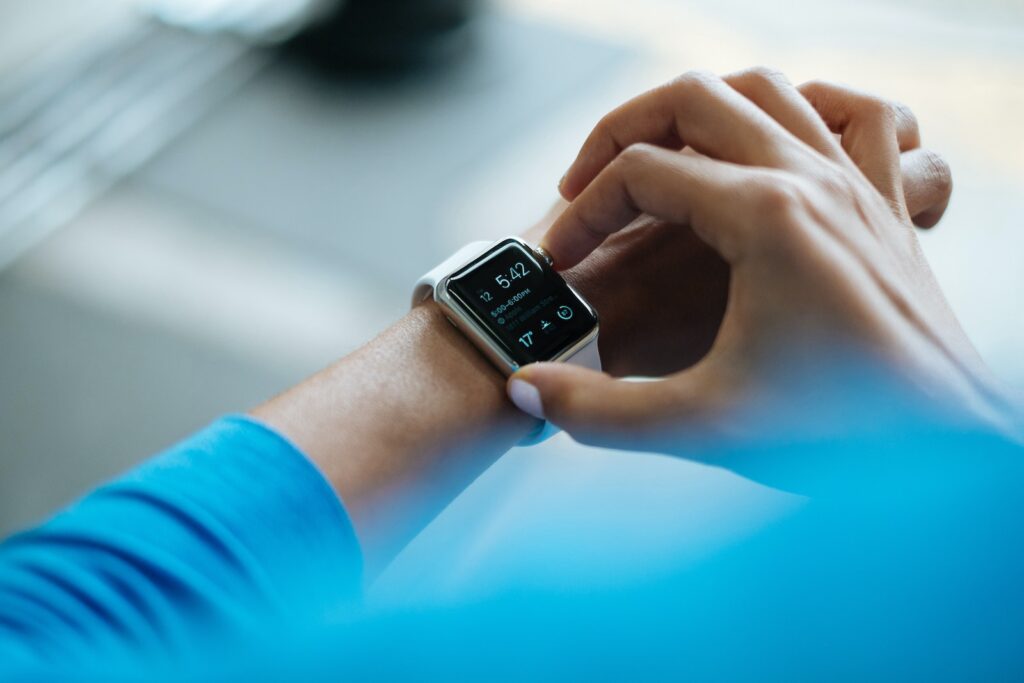Table of Contents
Introduction to Wearable Technology and Chronic Diseases
Wearable technology, which includes smartwatches, activity trackers, and biometric sensors, has become increasingly popular in recent years. These devices are designed to collect data on our daily habits, such as physical activity levels, sleep patterns and heart rate. However, wearable technology is not just useful for fitness tracking but also in monitoring chronic diseases.
A chronic disease refers to a long-term illness that requires ongoing management or treatment. It can include conditions like diabetes mellitus (DM), hypertension (HTN), cardiovascular diseases (CVDs) among others. Managing these kinds of health issues could be challenging since they require continuous monitoring and frequent visits to the doctor’s office.
Wearable tech may offer an innovative way to help patients monitor their vital signs more efficiently compared with traditional measures.
In addition:
- Patients can use wearables at any time throughout the day without disrupting their routines.
- They receive real-time insights into their health status by providing essential medical information through alerts.
- Doctors can gain valuable insights into a patient’s behavior outside of clinic visits thus enabling them to make more informed diagnoses and personalized treatments plans.
The next sections will delve into deeper details about how wearable technology helps people manage chronic illnesses effectively while improving outcomes.
Benefits of Using Wearable Devices in Monitoring Chronic Conditions
Wearable technology has revolutionized the healthcare industry, particularly in chronic disease management. Here are some benefits of using wearable devices:
- Increase self-awareness: Wearables provide patients with detailed insights into their health and wellbeing, allowing them to monitor various biometric data points such as heart rate, blood pressure and glucose levels. Patients can use this information to gain a better understanding of how their body reacts to different situations or activities.
- Better treatment adherence: For chronic conditions like diabetes or hypertension, regular monitoring is crucial for successful treatment outcomes. However, it can be difficult for patients to remember when and how often they need to measure certain parameters. Wearable devices simplify this process by automatically recording the necessary data throughout the day without interruption.
- Data-driven decision making: Real-time tracking allows doctors and caregivers access to patient-specific health metrics that help inform medical decisions on an ongoing basis rather than relying on intermittent visits alone.
- Cost-efficient care delivery: Remote monitoring enabled by wearables reduces the number of physical hospital visits needed which leads both saving time as well as financial resources for both healthcare providers and patients alike.
- Promote healthy habits:The integration of user-friendly interfaces similar in appearance with popular apps provides easier adoption while encouraging users toward regular engagement creating a culture around wellness-minded lifestyles -this boosts motivation through behavior modification protocols like gamification within these applications which drives continued habit formation long after initial adoption occurs.
Overall, wearable technology simplifies daily life significantly helping manage chronic symptoms more efficiently ultimately leading to an improved quality of life.
Popular Examples of Wearable Devices for Tracking Chronic Diseases
Wearable devices have become increasingly popular in managing and tracking chronic diseases, as they provide continuous monitoring of vital signs and can alert patients or doctors of any changes that may require medical attention. Here are some popular examples:
1. Continuous Glucose Monitoring (CGM) Devices
CGM devices are commonly used by people with diabetes to monitor their blood sugar levels throughout the day and night. The device is worn on the body, either as a patch or an implantable sensor, which measures glucose levels in interstitial fluid.
2. Smart Watches
Smart watches can track various health metrics such as heart rate, sleep patterns, physical activity levels, and even ECG measurements depending on the model. These features make them useful for individuals living with cardiovascular disease or other conditions that require regular monitoring.
3. Activity Trackers
Activity trackers allow users to monitor daily physical activities such as steps taken, calories burned, distance covered while walking/running etc., This type of wearable technology helps individuals manage conditions like obesity and hypertension by setting fitness goals and tracking progress over time.
4. Pulse Oximeters
Pulse oximeters measure oxygen saturation level & pulse rate non-invasively (by clip-on probes), making it easier for those suffering from respiratory illnesses like asthma & COPD to keep track of their breathing rates when conducting activities at home or outside.
5. Blood Pressure Monitors
Blood pressure monitors often come integrated into smartwatches/wristbands or standalone units that use Bluetooth connectivity technology to sync data about BP readings directly onto smartphones & tablets via companion apps . Users can easily share this information with healthcare professionals who keep tabs on how well they’re doing against established treatment guidelines set out by regulatory bodies worldwide.
6. Sleep Monitors
Sleep monitors provide users with detailed data on their sleep stages – deep, light and REM sleep & the duration of each stage – helping individuals identify patterns that could lead to better quality rest and a more overall healthy lifestyle. This is particularly useful for people living with chronic insomnia or other sleep disorders.
In conclusion, wearable technology has revolutionized the way we manage and monitor our health by providing unprecedented access to real-time medical data. Although there are many types of wearables available in the market, choosing one that best suits you boils down to your specific needs as well as compatibility with other devices and apps you use daily.
Features to Look for When Choosing a Wearable Device for Managing Your Health
With the increasing availability of wearable technology, individuals suffering from chronic diseases now have access to tools that can help them manage their conditions more effectively. However, not all wearables are created equal. When choosing a wearable device for managing your health, there are several features you should consider.
- Accuracy: The accuracy of the readings provided by your wearable device is crucial in managing chronic diseases. Ensure that the device has been tested and validated by relevant regulatory bodies such as the FDA or CE before making a purchase.
- Battery life: It’s essential to choose a wearable with long battery life since it’s something you’ll be wearing throughout the day for extended periods. Be sure to check how often it needs charging.
- Data management: A good wearable device should allow easy tracking, analyzing and sharing data with your healthcare provider so they can monitor progress accurately and adjust treatment plans accordingly.
- User-friendly interface: An excellent user interface ensures ease-of-use and readability on small screens while providing straightforward navigation options during monitoring sessions.
- Mobility/flexibility:The ideal candidate should not hinder mobility or cause discomfort when worn for prolonged periods – especially important if you need it regularly such as during physical therapy sessions or daily walks/runs/hikes!
- Durability:Finally look out for durable materials which will withstand regular use over time without being damaged easily.
Careful consideration of these features will ensure that you select an appropriate tool best suited towards helping manage your unique condition efficiently.
Challenges with Implementing Wearables in Healthcare Settings
The rise of wearable technology has opened up new possibilities for managing chronic conditions such as diabetes, heart disease, and asthma. However, there are several challenges that need to be overcome before wearables can become a seamless part of healthcare delivery. The following are some of the main hurdles:
- Lack of integration with existing health IT systems – One of the biggest barriers to incorporating wearables into healthcare settings is the difficulty in integrating these devices with electronic health records (EHRs) and other clinical information systems. This can lead to data silos where information from wearables is not easily accessible or actionable by healthcare providers.
- Data privacy concerns – Patient data protection is a paramount concern when it comes to using wearable technology in healthcare. Health data collected through these devices must be properly secured and managed in accordance with HIPAA regulations.
- Inadequate reimbursement policies – Health insurance providers currently do not cover the cost of most wearables used for monitoring chronic diseases meaning individuals have pay out-of-pocket expenses that may potentially limit their affordability or use.
- User engagement issues – The success of any wearable device depends on patients’ willingness to regularly monitor themselves which may pose significant effort especially over long period for those who suffer from complex conditions like end-stage renal failure or COPD who often require continuous self-monitoring . Providers must ensure that they take action based on this user-generated feedback and facilitate meaningful communication between patients and clinicians.
- Data accuracy limitations/limitations – Certain factors like skin pigmentation levels, body movements etc impair accurate measurement/sampling thereby leading to erroneous readings and results. Providers must establish the acceptable limitations of wearables in managing chronic diseases to prevent misdiagnosis or inappropriate treatment.
These challenges notwithstanding, wearable technology has a lot of potential for improving patient outcomes and delivering cost-effective care. Healthcare providers need to work closely with developers, manufacturers, patients, regulators and insurers to find solutions that address these pain points effectively while ensuring that wellness is optimized for all involved parties including patients
Future Applications and Innovations of Wearables in Chronic Disease Management
Wearable technology has revolutionized the way we monitor chronic diseases. As technology continues to advance, it’s exciting to consider what future applications and innovations could bring.
One area of potential growth is in personalized medicine. Wearables can collect data on an individual’s unique health profile, allowing for customized treatment plans. For example, a wearable device could track a patient’s heart rate variability and provide targeted stress reduction techniques based on their specific needs.
The use of artificial intelligence (AI) is another area where wearables are showing promise. AI algorithms can analyze large amounts of health data collected by wearables and provide insights for patients and healthcare providers alike. This information can help predict disease progression or identify potential complications before they become serious.
New types of sensors are also being developed that could expand the capabilities of wearables further. Some examples include devices that measure glucose levels non-invasively or detect changes in sweat composition to diagnose conditions such as cystic fibrosis.
Another exciting development in wearable tech is the integration with telemedicine services. Patients can now connect with healthcare professionals remotely through their wearable devices, reducing the need for office visits while maintaining ongoing monitoring and support.
In conclusion, there is no doubt that wearable technology will continue to transform chronic disease management as new innovations emerge. From personalized treatments to AI analysis, these advancements have enormous potential benefits for both patients and care providers alike.




